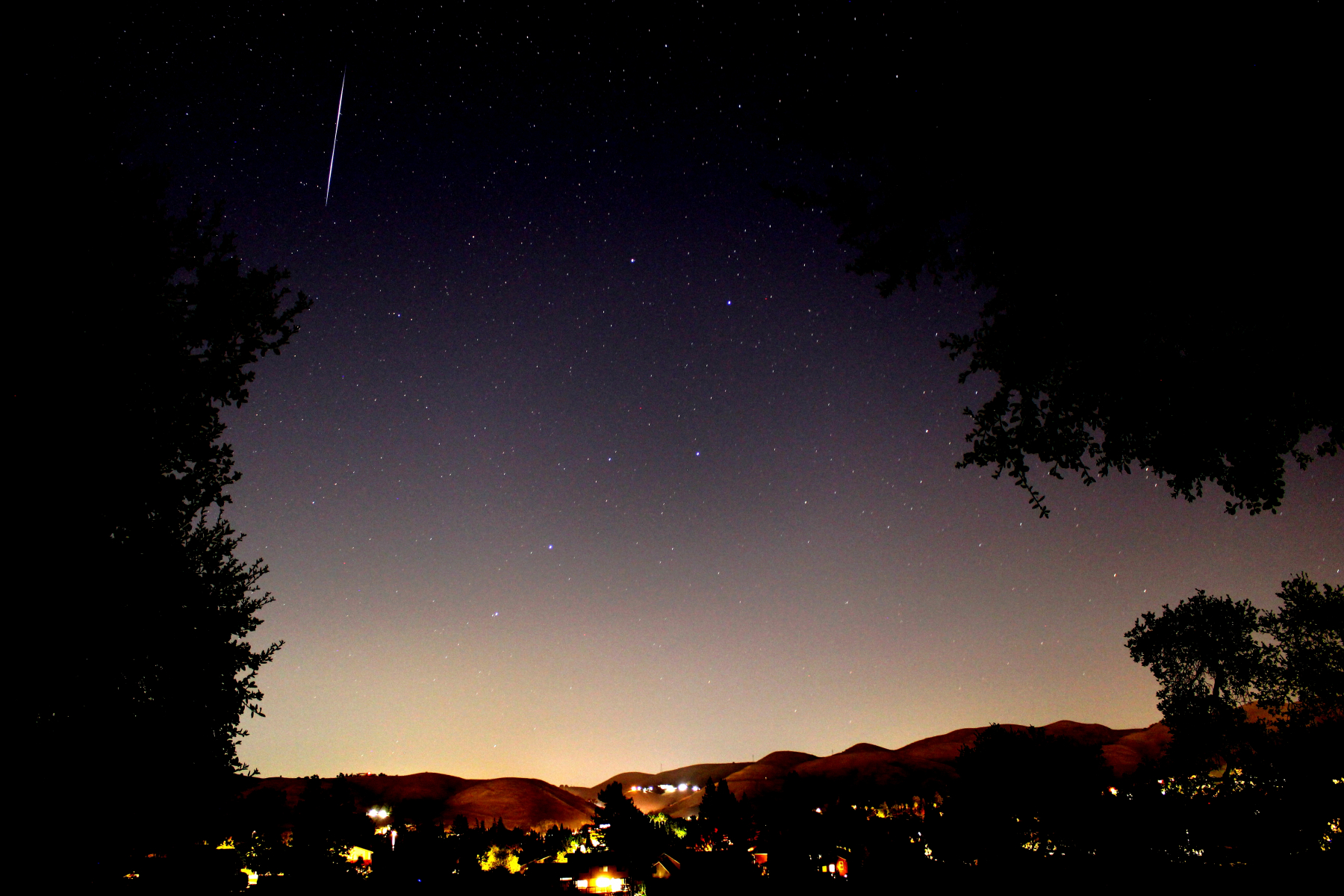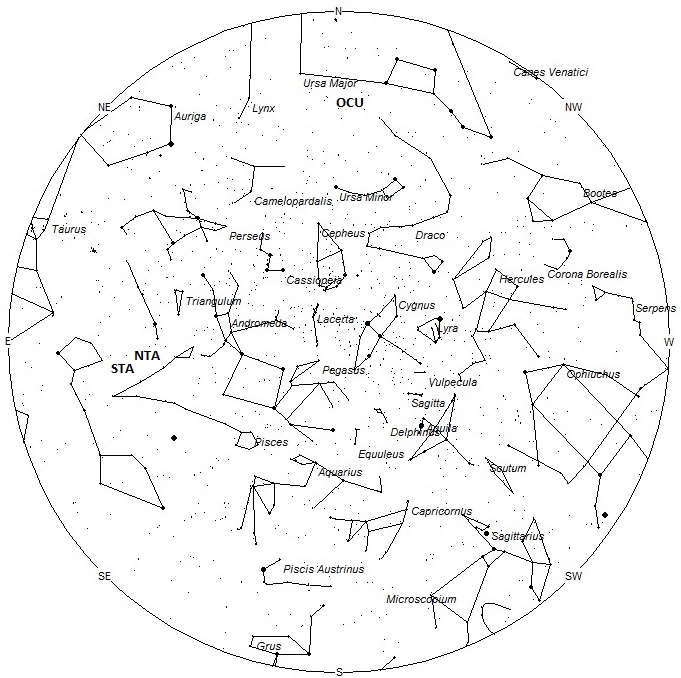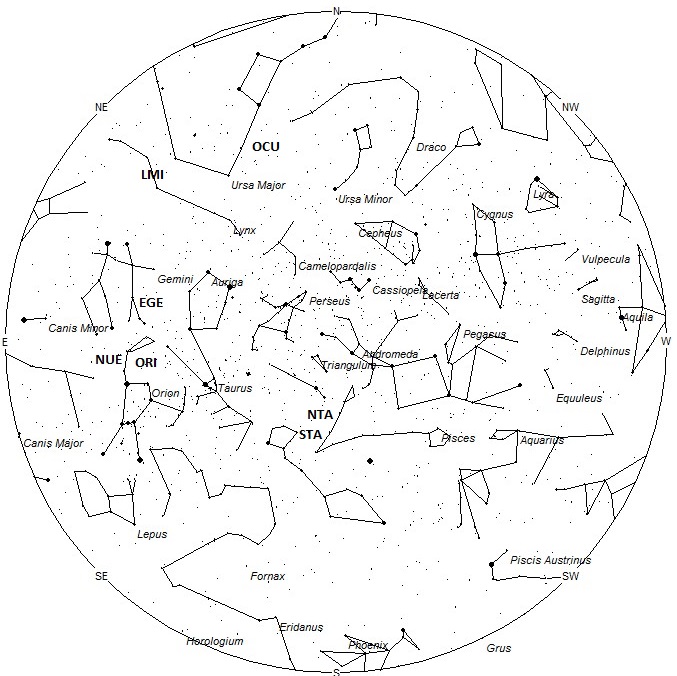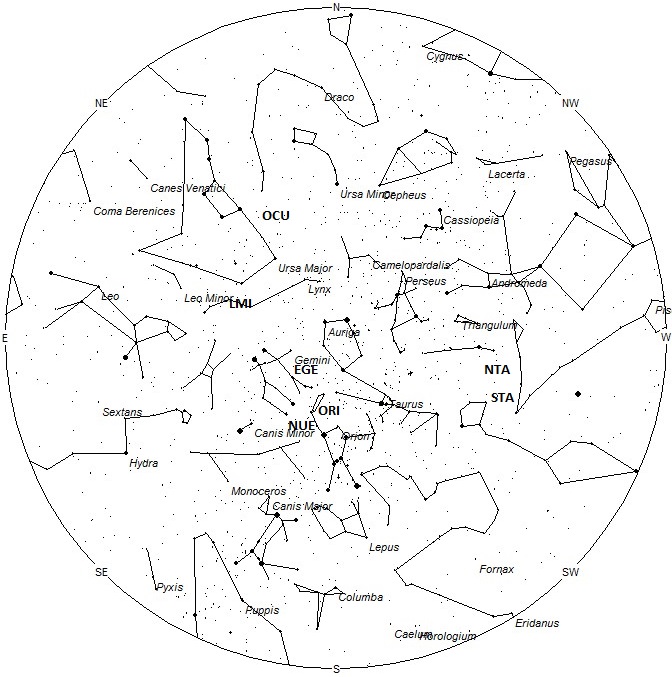
During this period the moon reaches its full phase on Sunday October 13th. At this time the moon will be located opposite the sun and lie above the horizon all night long. Toward the end of this period there will be a moonless period of a couple of hours between dusk and moonrise. Unfortunately meteor rates at this time are very low. The estimated total hourly meteor rates for evening observers this week is near 3 for those viewing from the northern hemisphere and 2 for those located south of the equator. For morning observers the estimated total hourly rates should be near 12 as seen from mid-northern latitudes (45N) and 7 as seen from tropical southern locations (25S) . The actual rates will also depend on factors such as personal light and motion perception, local weather conditions, alertness and experience in watching meteor activity. Rates are reduced during this period due to moonlight. Note that the hourly rates listed below are estimates as viewed from dark sky sites away from urban light sources. Observers viewing from urban areas will see less activity as only the brightest meteors will be visible from such locations.
The radiant (the area of the sky where meteors appear to shoot from) positions and rates listed below are exact for Saturday night/Sunday morning October 12/13. These positions do not change greatly day to day so the listed coordinates may be used during this entire period. Most star atlases (available at science stores and planetariums) will provide maps with grid lines of the celestial coordinates so that you may find out exactly where these positions are located in the sky. A planisphere or computer planetarium program is also useful in showing the sky at any time of night on any date of the year. Activity from each radiant is best seen when it is positioned highest in the sky, either due north or south along the meridian, depending on your latitude. It must be remembered that meteor activity is rarely seen at the radiant position. Rather they shoot outwards from the radiant so it is best to center your field of view so that the radiant lies at the edge and not the center. Viewing there will allow you to easily trace the path of each meteor back to the radiant (if it is a shower member) or in another direction if it is a sporadic. Meteor activity is not seen from radiants that are located below the horizon. The positions below are listed in a west to east manner in order of right ascension (celestial longitude). The positions listed first are located further west therefore are accessible earlier in the night while those listed further down the list rise later in the night.
These sources of meteoric activity are expected to be active this week.
.
Detailed descriptions of each source will continue next week when viewing conditions improve.
| SHOWER | DATE OF MAXIMUM ACTIVITY | CELESTIAL POSITION | ENTRY VELOCITY | CULMINATION | HOURLY RATE | CLASS |
| RA (RA in Deg.) DEC | Km/Sec | Local Daylight Saving Time | North-South | |||
| Northern Taurids (NTA) | Nov 03 | 01:54 (028) +16 | 28 | 02:00 | 1 – <1 | II |
| Southern Taurids (STA) | Oct 10 | 02:08 (032) +09 | 27 | 02:00 | 2 – 2 | II |
| Orionids (ORI) | Oct 22 | 05:46 (087) +16 | 67 | 05:00 | 3 – 2 | I |
| epsilon Geminids (EGE) | Oct 11 | 06:24 (096) +28 | 70 | 06:00 | 1 – <1 | II |
| nu Eridanids (NUE) | Sep 24 | 06:20 (095) +10 | 67 | 06:00 | <1 – <1 | IV |
| October Ursa Majorids (OCU) | Oct 15 | 09:40 (145) +65 | 56 | 09:00 | <1 – <1 | IV |
| Leonis Minorids (LMI) | Oct 23 | 10:02 (151) +40 | 62 | 10:00 | <1 – <1 | II |
 American Meteor Society
American Meteor Society



Tonight, on Tues 10/15/2019 I observed from Raleigh, NC a downward falling star that blasted through our atmosphere with full, colored trails for approx 2.5 sec and then flashed back to white. The full moon appeared slowly from the left of it about an hour later. Yes, I have zero accuracy to the proximity of the meteorite (or -roid) except from where I was sitting amongst the buildings.
I also saw one in spartanburg sc around the 10th
I saw one on the18 of October around 8pm